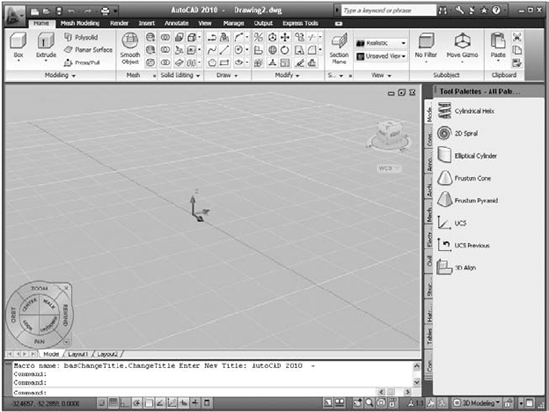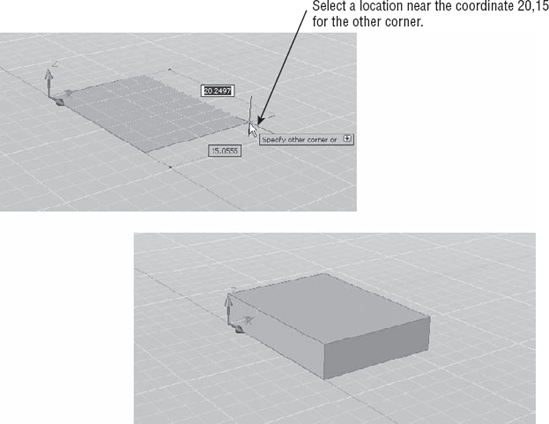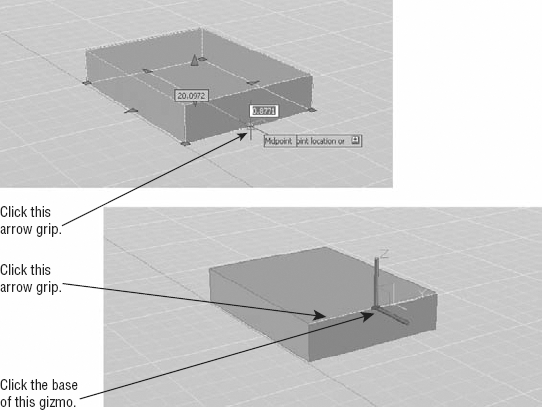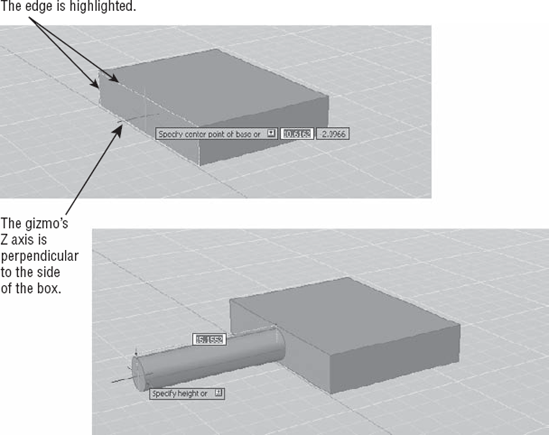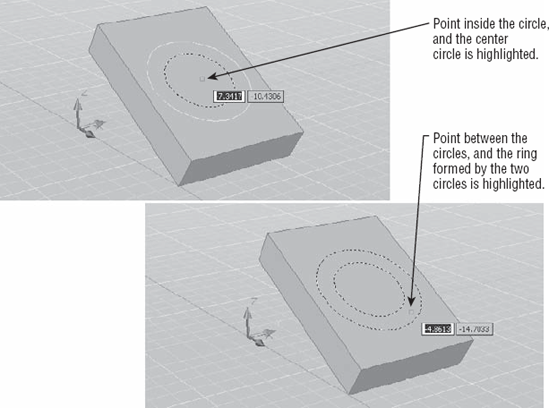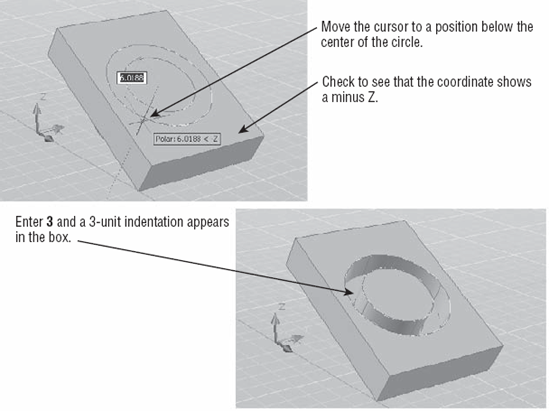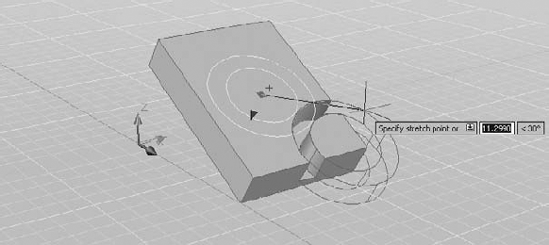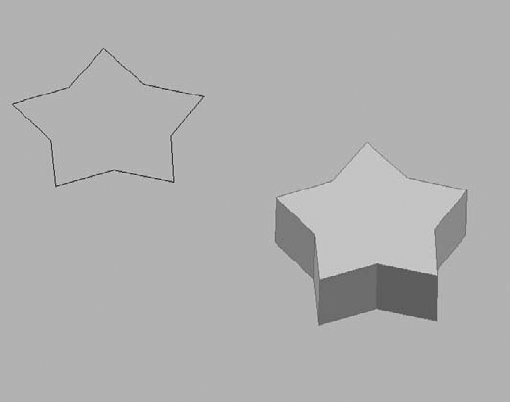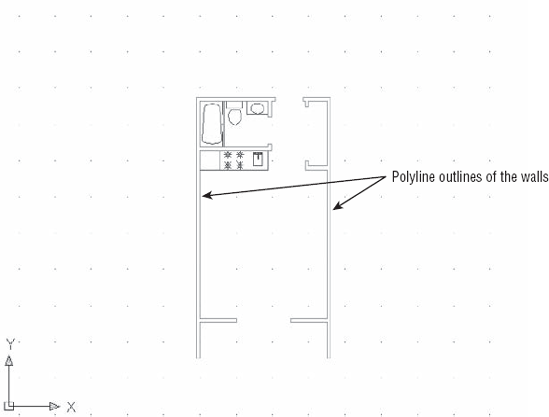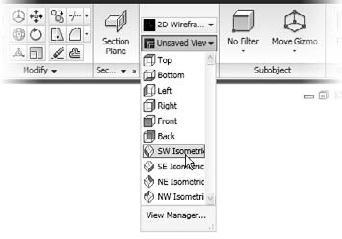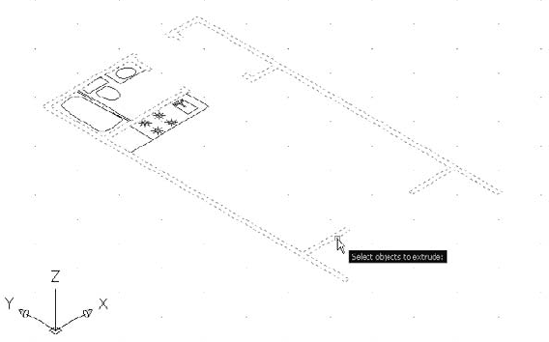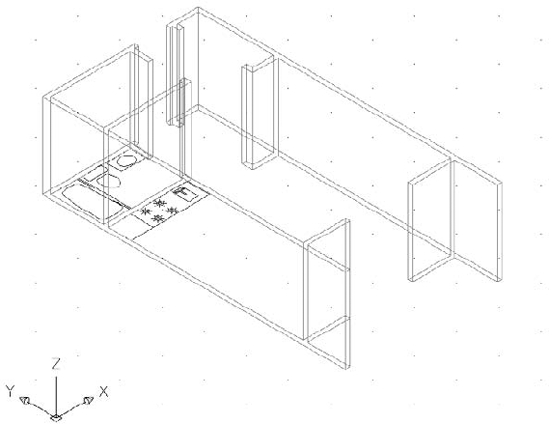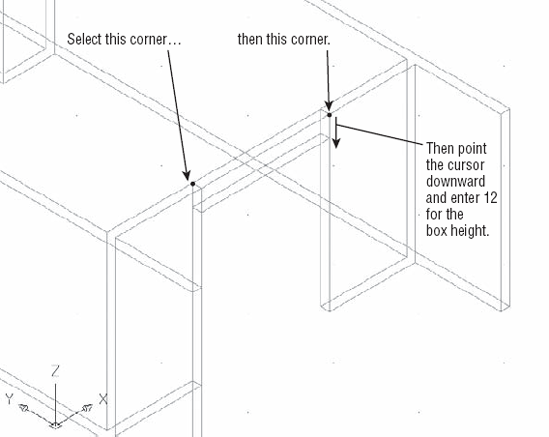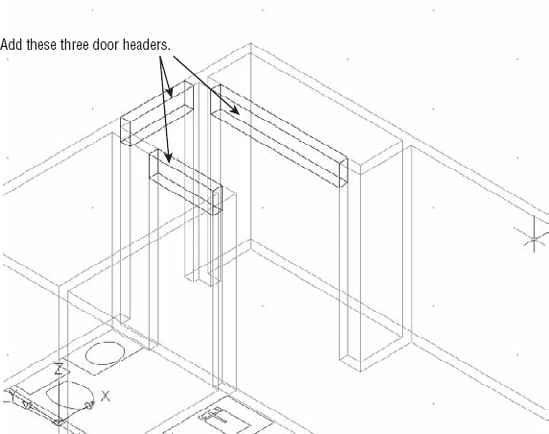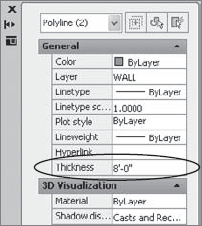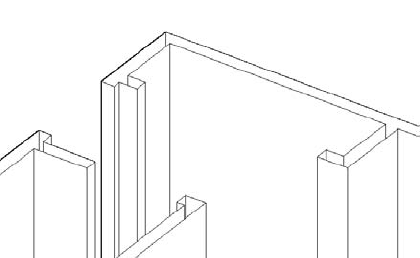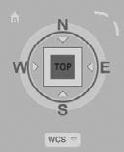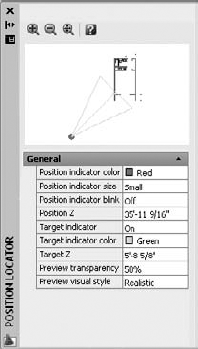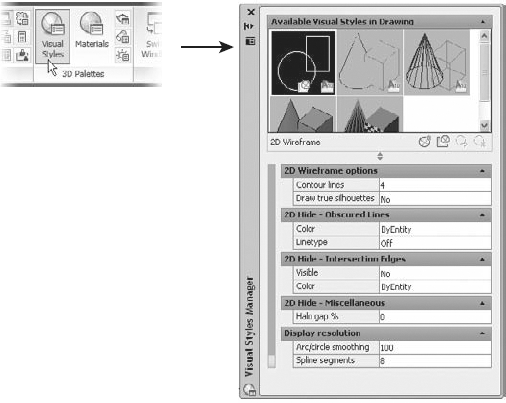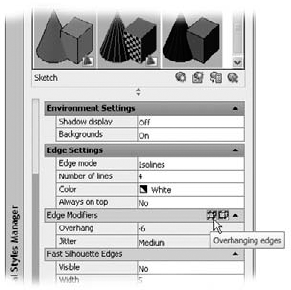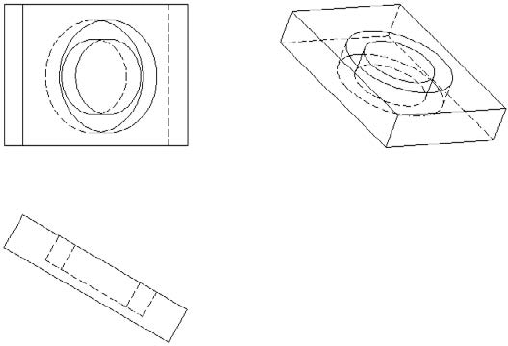Viewing an object in three dimensions gives you a sense of its true shape and form. It also helps you conceptualize your design, which results in better design decisions. In addition, using three-dimensional objects helps you communicate your ideas to those who may not be familiar with the plans, sections, and side views of your design.
A further advantage to drawing in three dimensions is that you can derive 2D drawings from your 3D models, which may take considerably more time with standard 2D drawing methods. For example, you can model a mechanical part in 3D and then quickly derive its 2D top, front, and right-side views by using the techniques discussed in this chapter.
In this chapter you'll learn to do the following:
Most of this book is devoted to showing you how to work in the 2D Drafting & Annotation workspace. This workspace is basically a 2D drawing environment, although you can certainly work in 3D as well.
AutoCAD offers something called the 3D Modeling workspace, which gives you a set of tools to help ease your way into 3D modeling. This 3D Modeling workspace gives AutoCAD a different set of Ribbon panels, but don't worry. AutoCAD behaves in the same basic way, and the AutoCAD files produced are the same regardless of whether they're 2D or 3D drawings.
To get to the 3D Modeling workspace, you need to click the Workspace Switching tool in the status bar and then select 3D Modeling (see Figure 21.1).
If you're starting a new 3D model, you'll also want to create a new file using a 3D template. Try the following to get started with 3D modeling:
Start AutoCAD, and then click on the Workspace Switching tool in the status bar and select 3D Modeling. You'll see a new set of panels appear as well as the Tool Palettes window.
Next, to create a new 3D modeling file, click New in the Quick Access toolbar to open the Select Template dialog box. Select the
acad3D.dwttemplate file and click Open. Your screen will look similar to Figure 21.2.
The drawing area displays the workspace as a perspective view with a gray background and a grid. This is really just a typical AutoCAD drawing file with a couple of setting changes. The view has been set up to be a perspective view by default, and a feature called Visual Styles has been set to show 3D objects as solid objects. You'll learn more about the tools you can use to adjust the appearance of your workspace later in this chapter. For now, let's look at the tool palette and Ribbon that appear in the AutoCAD window.
To the far right is the AutoCAD Tool Palettes window that you've already seen; it contains shortcuts to various AutoCAD tools. The 3D Modeling workspace opens the Tool Palettes window. If this is the first time you've seen the tool palettes, you'll see the Modeling tab, which contains a sampling of 3D tools.
The Ribbon along the top of the AutoCAD window offers all the tools you'll need to create 3D models. The 3D Modeling workspace Ribbon offers many of the same tabs and panels you're already familiar with, but it also includes some new ones (see Figure 21.3). You see the familiar Draw and Modify panels in the Home tab, but there are several other panels devoted to 3D modeling: Modeling, Mesh, Solid Editing, View, and Subobject.
In addition, other Ribbon tabs offer more sets of tools designed for 3D modeling. For example, the Render tab contains tools that control the way the model looks. You can set up lighting and shadows and apply materials to objects such as brick or glass. You can also control the way AutoCAD displays the model through the Visual Styles, Edge Effects, Lights, Sun & Location, and Materials panels. In the next section, you'll gain firsthand experience creating and editing some 3D shapes using the Home tab's Modeling and View panels and the Render tab's Visual Styles panels. This way, you'll get a feel for how things work in the 3D Modeling workspace.
You can work with two types of 3D objects in AutoCAD: solids and surfaces. You can treat solid objects as if they're solid material. For example, you can create a box and then remove shapes from the box as if you're carving it, as shown in Figure 21.4.
With surfaces, you create complex surface shapes by building on lines, arcs, or polylines. For example, you can quickly turn a series of curved polylines, arcs, or lines into a warped surface, as shown in Figure 21.5.

Figure 21.5. Using the Loft tool, you can use a set of 2D objects (left) to define a complex surface (right).
Next, you'll learn how to create a solid box and then make simple changes to it as an introduction to 3D modeling.
Start by creating a box using the Box tool in the Home tab's Modeling panel:
Close the Tool Palettes window. You won't need it for this chapter.
Click the Box tool from the Solids flyout on the Home tab's Modeling panel.
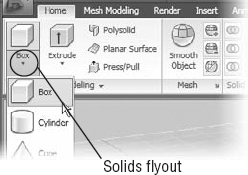
Click a point near the origin of the drawing shown in Figure 21.6. You can use the coordinate readout to select a point near 0,0. Once you click, you see a rectangle follow the cursor.
Click another point near coordinate 20,15, as shown in Figure 21.6. As you move the cursor, the rectangle is fixed and the height of the 3D box appears.
Enter 4

You used three basic steps in creating the box. First, you clicked one corner to establish a location for the box. Then, you clicked another corner to establish the base size. Finally, you selected a height. You use a similar set of steps to create any of the other 3D solid primitives found in the Solids flyout of the Home tab's Modeling panel. For example, for a cylinder, you select the center, then the radius, and finally the height. For a wedge, you select two corners as you did with the box, and then you select the height. You'll learn more about these 3D solid primitives in Chapter 24.
Once you've created a solid, you can fine-tune its shape by using grips:
Adjust your view so it looks similar to Figure 21.7, and then click the solid to select it. Grips appear on the 3D solid, as shown in the figure.
You can adjust the location of the square grips at the base of the solid in a way that is similar to adjusting the grips on 2D objects. The arrow grips let you adjust the length of the site to which the arrows are attached. If you click an arrow grip and you have Dynamic Input turned on, a dimension appears at the cursor, as shown in Figure 21.7. You can enter a new dimension for the length associated with the selected grip, or you can drag and click the arrow to adjust the length. Remember that you can press the Tab key to shift between dimensions shown in the Dynamic Input display.
If your Ctrl+click doesn't work as described, you may need to change the setting for the Legacyctrlpick system variable. At the Command prompt, enter legacyctrlpick

Click the arrow grip toward the front of the box, as shown at upper left in Figure 21.7. Now, as you move the cursor, the box changes in length.
Press Esc to clear the grip selection.
You can also move individual edges by using a Ctrl+click:
Ctrl+click the top-front edge, as shown at lower right in Figure 21.7. The edge is highlighted, and a graphic tool called a gizmo appears at its midpoint. The gizmo has three legs pointing in the X, Y, and Z axes. It also has a grip at the base of the three legs.
Click the grip at the base of the gizmo, and move the cursor. The edge follows the grip.
Hold down the Shift key, and pull the grip forward, away from the box's center. The Shift key constrains the motion in the X, Y, or Z axis.
Click a point to fix the edge's new position.
Click the Undo button to return the box to its original shape.
As you can see, you have a great deal of flexibility in controlling the shape of the box. Using the Shift key lets you constrain the motion of the grip.
You were introduced to the gizmo in the last exercise. This is an icon that looks like the UCS icon and appears whenever you select a 3D solid or any part of a 3D solid. Try the next exercise to see how the gizmo works:
Ctrl+click the top-front edge of the box again to expose the edge's grip.
Place the cursor on the blue Z axis of the gizmo, but don't click. A blue line appears that extends across the drawing area, and the Z axis of the gizmo changes color, as shown in Figure 21.8.
Click the Z axis. Now, as you move the cursor, the grip motion is constrained in the Z axis.
Click again to fix the location of the grip.
Press the Esc key to clear your grip selection.

Here you used the gizmo to change the Z location of a grip easily. You can use the gizmo to modify the location of a single grip or the entire object.
Typically, you work in what is known as the World Coordinate System (WCS). This is the default coordinate system that AutoCAD uses in new drawings, but you can also create your own coordinate systems that are subsets of the WCS. A coordinate system that you create is known as a User Coordinate System (UCS).
UCSs are significant in 3D modeling because they can help you orient your work in 3D space. For example, you could set up a UCS on a vertical face of the 3D box you created earlier. You could then draw on that vertical face just as you would on the drawing's WCS. Figure 21.9 shows a cylinder drawn on the side of a box. If you click on the Cylinder tool, for example, and place the cursor on the side of the box, the edge of the side will be highlighted to indicate the surface that the cylinder will be applied to. In addition, if you could see the cursor in color, you would see that the blue Z axis is pointing sideways to the left and is perpendicular to the side of the box.
The UCS has always been an important tool for 3D modeling in AutoCAD. AutoCAD 2007 introduced the Dynamic UCS, which automatically changes the orientation of the X, Y, and Z axes to conform to the flat surface of a 3D object.
You may have noticed that when you created the new 3D file using the acad3D.dwt template, the cursor looked different. Instead of the usual cross, you saw three intersecting lines. If you look carefully, you'll see that each line of the cursor is a different color. In its default configuration, AutoCAD shows a red line for the X axis, a green line for the Y axis, and a blue line for the Z axis. This mimics the color scheme of the UCS icon, as shown in Figure 21.10.
As you work with the Dynamic UCS, you'll see that the orientation of these lines changes when you point at a surface on a 3D object. The following exercise shows you how to use the Dynamic UCS to help you rotate the box about the X axis:
Be sure the Object Snap and Allow/Disallow Dynamic UCS features are turned on.


At the
Select objects:prompt, click the box, and then press
At the
Specify base point:prompt, don't click anything, but move the cursor from one surface of the box to a side of the box. As you do this, pay attention to the orientation of the cursor. It changes depending on which surface you're pointing to.Place the cursor on the left side, as shown in the top image of Figure 21.11.
Place the Osnap marker on the lower-front corner of the box, as shown in the top image in Figure 21.11. Click this corner. As you move the cursor, the box rotates about the Y axis.
Enter −30 for the rotation angle. Your box should look like the image at the bottom in Figure 21.11.
Here you saw that you can hover over a surface to indicate the plane about which the rotation is to occur. Now, suppose you want to add an object to one of the sides of the rotated box. The next section will show you another essential tool, one you can use to do just that.
In the rotation exercise, you saw that you can hover over a surface to indicate the plane of rotation. You can use the same method to indicate the plane on which you want to place an object. Try the following exercise to see how it's done:

Place the cursor on the top surface of the rectangle, as indicated in the top image of Figure 21.12, and hold it there for a moment. The cursor aligns with the angle of the top surface.
With the cursor aligned with the top surface of the box, click a point roughly at the center of the box. The circle appears on the surface, and as you move the cursor, the circle's radius follows.
Adjust the circle so it's roughly the same 6-unit radius as the one shown on the lower image in Figure 21.12, and then click to set the radius. You can also enter 6


This demonstrates that you can use Dynamic UCS to align objects with the surface of an object. Note that Dynamic UCS works only on flat surfaces. For example, you can't use it to place an object on the curved side of a cylinder.
You've just added a 2D circle to the top surface of the 3D box. AutoCAD offers a tool that lets you use that 2D circle or any closed 2D shape to modify the shape of your 3D object. The Presspull tool in the Home tab's Modeling panel lets you "press" or "pull" a 3D shape to or from the surface of a 3D object. The following exercise shows how this works:


Place the cursor over the center of the inner circle, but don't click yet. The circle is highlighted. (See the top-left panel of Figure 21.13.)
Move the cursor to the top surface of the box between both circles. The area between the circles is highlighted. (See the lower-right panel of Figure 21.13.)
With the cursor between the two circles, click the mouse. As you move the mouse, the circular area defined by the two circles moves.
Adjust the cursor location so the polar coordinate readout shows a minus Z (–Z), as shown in the top-left panel of Figure 21.14. Enter 3

You've created a circular indentation in the box by pressing the circular area defined by the two circles. You could have pulled the area upward to form a circular ridge on the box. Pressing the circle into the solid is essentially the same as subtracting one solid from another. When you press the shape into the solid, AutoCAD assumes you want to subtract the shape.
Presspull works with any closed 2D shape, such as a circle, closed polyline, or other completely enclosed area. An existing 3D solid isn't needed. For example, you can draw two concentric circles without the 3D box and then use Presspull to convert the circles into a 3D solid ring. In the previous exercise, the solid box showed that you can use Presspull to subtract a shape from an existing solid.
As you saw in this exercise, the Presspull tool can help you quickly subtract a shape from an existing 3D solid. Figure 21.15 shows some other examples of how you can use Presspull. For example, you can draw a line from one edge to another and then use Presspull to extrude the resulting triangular shape. You can also draw concentric shapes and extrude them; you can even use offset spline curves to add a trough to a solid.
When you're creating a 3D model, you'll hardly ever get the shape right the first time. Suppose you decide that you need to modify the shape you've created so far by moving the hole from the center of the box to a corner. The next exercise will show you how you can gain access to the individual components of a 3D solid to make changes.
The model you've been working with is composed of two objects: a box and a cylinder. These two components of the solid are referred to as subobjects of the main solid object. Faces and edges of 3D solids are also considered subobjects. When you use the Union, Subtract, or Intersect tool on a set of objects, the objects merge into a single solid—or at least that is how it seems at first. You can gain access to and modify the shape of the subobjects from which the shape is constructed by using the Ctrl key while clicking the solid. Try the following:
Place the cursor on the components of the solid you've made so far. They are highlighted as if they were one object. If you were to click it (don't do it yet), the entire object would be selected.
Hold down the Ctrl key, and move the cursor over the circular indentation. As you do this, the indentation is highlighted (see the left image in Figure 21.16).
While still holding down the Ctrl key, click the indentation. The grips for the indentation appear, as shown in the lower-right image in Figure 21.16. As you may guess, you can use these grips to change the shape and location of a feature of the selected solid.
Click the center square grip of the indentation, and move your cursor around. If you find it a bit uncontrollable, turn off Polar mode. As you move the cursor, the indentation moves with it.
Place the indentation in the location shown in Figure 21.17 and click. You've just moved the indentation from the center to the edge of the cylinder.
This example showed that the Ctrl key can be an extremely useful tool when you have to edit a solid; it allows you to select the subobjects that form your model. Once the subobjects are selected, you can move them, or you can use the arrow grips to change their size.
3D solid primitives are great for creating basic shapes, but in many situations, you'll want to create a 3D form from a more complex shape. Fortunately, you can extrude 2D objects into a variety of shapes using additional tools found in the Home tab's Modeling panel. For example, you can draw a shape like a star and then extrude it into a third dimension, as shown in Figure 21.18. Alternatively, you can use several strategically placed 2D objects to form a flowing surface like the wing of an airplane.
You can create a 3D solid by extruding a 2D closed polyline. This is a more flexible way to create shapes because you can create a polyline of any shape and extrude it to a fairly complex form.
In the following set of exercises, you'll turn the apartment room from previous chapters into a 3D model. I've created a version of the apartment floor plan that has a few additions to make things a little easier for you. Figure 21.19 shows the file you'll use in the exercise. It's the same floor plan you've been working with in earlier chapters but with the addition of closed polylines outlining the walls.
The plan isn't shaded as in the previous examples in this chapter. You can work in 3D in this display mode just as easily as in a shaded mode:
Open the
21-unit.dwgfile. Metric users should open21-unit-metric.dwg.Choose Southwest Isometric from 3D View drop-down list in the Home tab's View panel (Figure 21.20). You can also type -View

Your view now looks as if you're standing above and to the left of your drawing rather than directly above it (see Figure 21.21). The UCS icon helps you get a sense of your new orientation.
Click the Extrude tool in the Home tab's Modeling panel (see Figure 21.22).
You can also enter Extrude
Select the wall outlines shown in Figure 21.21, and then press

At the
Specify height of extrusion or [Direction/Path/Taper angle] <0.0000>:prompt, enter 8′
Unlike in the earlier exercise with the box, you can see through the walls because this is a Wireframe view. A Wireframe view shows the volume of a 3D object by displaying the lines representing the edges of surfaces. Later in this chapter, I'll discuss how to make an object's surfaces appear opaque as they do on the box earlier in this chapter.
Next you'll add door headers to define the wall openings:
Adjust your view so you get a close look at the door shown in Figure 21.24. You can use the Pan and Zoom tools in this 3D view as you would in a 2D view.
Turn off Dynamic UCS mode by clicking the Allow/Disallow Dynamic UCS tool in the status bar so it's grayed out. This helps you avoid accidentally orienting your cursor to the wall behind the door header (Figure 21.25).

Use the Endpoint osnaps, and click the two points shown in Figure 21.26.
At the
Specify height or [2Point] <8′-0″>:prompt, point the cursor downward from the points you just selected, and enter 12
Repeat steps 4 and 5 to draw the other door headers shown in Figure 21.26.
The walls and door headers give you a better sense of the space in the unit plan. To enhance the appearance of the 3D model further, you can join the walls and door headers so they appear as seamless walls and openings:
Zoom out so you can see the entire unit, and then click the Union tool in the Solid Editing panel (Figure 21.27). You can also enter Uni

At the
Select objects:prompt, select all the walls and headers, and then press
Now the walls and headers appear as one seamless surface without any distracting joint lines. You can really get a sense of the space of the unit plan. You'll want to explore ways of viewing the unit in 3D, but before you do that, you need to know about one more 3D modeling feature: point filters.
AutoCAD offers a method for 3D point selection, called point filters, that can help you isolate the X, Y, or Z coordinate of a location in 3D. Point filters enable you to enter an X, Y, or Z value by picking a point on the screen and telling AutoCAD to use only the X, Y, or Z value of that point or any combination of those values. For example, suppose you want to start the corner of a 3D box at the X and Y coordinates of the corner of the unit plan but you want the Z location at 3′ instead of at ground level. You can use point filters to select only the X and Y coordinates of a point and then specify the Z coordinate as a separate value. The following exercise demonstrates how this works:
Zoom in to the balcony door, and turn on the F-Rail layer.

At the
Specify first corner or [Center]:prompt, Shift+right-click to display the Osnap menu, and then choose Point Filters
You may have noticed the .X, .Y, and .Z options on the Object Snap menu (Shift+right-click) in step 3. These are the 3D point filters. By choosing one of these options as you select points in a 3D command, you can filter an X, Y, or Z value, or any combination of values, from that selected point. You can also enter filters through the keyboard.
At the
Specify first corner or [Center]: .XY of:prompt, pick the corner of the unit plan, as shown in Figure 21.28.At the
(need Z):prompt, enter 36
At the
Specify other corner or [Cube/Length]:prompt, Shift+right-click to display the Osnap menu again, and choose Point Filters
At the
(need Z):prompt, a temporary outline of the box appears at the 36″ height. Click the mouse to fix the base outline of the box.Enter 4

In step 4, you selected the corner of the unit, but the box didn't appear right away. You had to enter a Z value in step 5 before the outline of the box appeared. Then, in step 6, you saw the box begin at the 36″ elevation. Using point filters allowed you to place the box accurately in the drawing even though there were no features that you could snap to directly.
Now that you've gotten most of the unit modeled in 3D, you'll want to be able to look at it from different angles. Next you'll see some of the tools available to control your views in 3D.
AutoCAD offers a number of tools to help you view your 3D model. You've already used one to get the current 3D view. Choosing Southwest Isometric from the View panel's drop-down list displays an isometric view from a southwest direction. You may have noticed several other isometric view options in that list. The following sections introduce you to some of the ways you can move around in your 3D model.
Figure 21.29 illustrates the isometric view options you saw earlier in the Home tab's View panel drop-down list: Southeast Isometric, Southwest Isometric, Northeast Isometric, and Northwest Isometric. The cameras represent the different viewpoint locations. You can get an idea of their location in reference to the grid and UCS icon.

Figure 21.29. The isometric viewpoints for the four isometric views available from the Home tab's View panel drop-down list
The Home tab's View panel's drop-down list also offers another set of options: Top, Bottom, Left, Right, Front, and Back. These are orthogonal views that show the sides, top, and bottom of the model, as illustrated in Figure 21.30. In this figure, the cameras once again show the points of view.
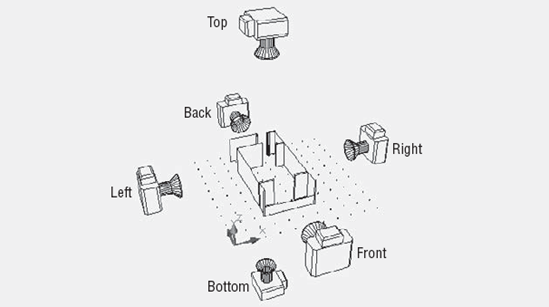
Figure 21.30. This diagram shows the six viewpoints of the orthogonal view options on the View 3D Views cascading menu.
When you use any of the view options described here, AutoCAD attempts to display the extents of the drawing. You can then use the Pan and Zoom tools to adjust your view.
You may find the isometric and orthogonal views a bit restrictive. The Orbit tool lets you move around your model in real time. You can fine-tune your view by clicking and dragging the mouse using this tool. Try the following to see how it works:
Zoom out so you see an overall view of your model.
Click the Orbit tool in the Orbit flyout on the View tab's Navigate panel.
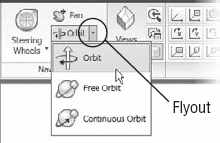
You can also enter 3dorbit

Click and drag in the drawing area. As you drag the mouse, the view revolves around your model. The cursor changes to an orbit icon to let you know you're in the middle of using the Constrained Orbit tool.
If you have several objects in your model, you can select an object that you want to revolve around and then click the Orbit tool. It also helps to pan your view so the object you select is in the center of the view.
When you've reached the view you want, right-click and choose Exit. You're then ready to make more changes or use another tool.
One of the first tasks you'll want to do with a model is to look at it from all angles. The ViewCube is the perfect tool for this purpose. The ViewCube is a device that lets you select a view by using a sample cube. You have already seen the ViewCube in the early part of this chapter. If it is not visible in your drawing, do the following:
First make sure Visual Style is set to something other than 2D Wireframe by selecting 3D Wireframe, 3D Hidden, Conceptual, or Realistic from the Visual Styles drop-down list in the Home tab's View panel.
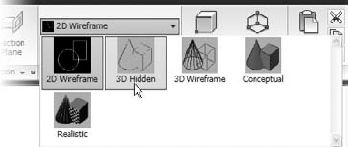
If you don't already see the ViewCube in the upper-right corner of the drawing area, then click the ViewCube tool in the View tab's Views panel.

The following list explains what you can do with the ViewCube (see Figure 21.31):
Click the Home icon to bring your view to the "home" position. This is helpful if you lose sight of your model.
You can get a top, front, right-side, or other orthogonal view just by clicking the word Top, Front, or Right on the ViewCube.
Click a corner of the cube to get an isometric-style view, or click an edge to get an "edge-on" view.
Click and drag the N, S, E, or W label to rotate the model in the XY plane.
To rotate your view of the object in 3D freely, click and drag the cube.
From the icon at the bottom, select an existing UCS or create a new one from the UCS list.
You can also change from a perspective view to a parallel projection view by right-clicking the cube and selecting Perspective or Parallel Projection.
When you are in a plan or top view, the ViewCube will look like a square, and when you hover your cursor over the cube, you'll see two curved arrows to the upper right of the cube (Figure 21.32).
You can click on any of the visible corners to go to an isometric view or click the double curved arrows to rotate the view 90 degrees. The four arrowheads that you see pointing toward the cube allow you to change to an orthographic view of any of the four sides.
AutoCAD uses a camera analogy to help you set up views in your 3D model. With a camera, you have a camera location and a target, and you can fine-tune both in AutoCAD. AutoCAD also offers the Swivel tool to let you adjust your view orientation. Using the Swivel tool is like keeping the camera stationary while pointing in a different direction. Click Pan on the View tab's Navigate panel, right-click, and select Other Navigation Modes
At first, the Swivel tool might seem just like the Pan tool. But in the 3D world, Pan actually moves both the camera and the target in unison. Using Pan is a bit like pointing a camera out the side of a moving car. If you don't keep the view in the camera fixed on an object, you are panning across the scenery. Using the Swivel tool is like standing on the side of the road and turning the camera to take in a panoramic view.
To use the Swivel tool, do the following:

Right-click in the drawing area, and choose Other Navigation Modes

Click and drag in the drawing to swivel your point of view.
When you have the view you want, right-click and select Exit.
If you happen to lose your view entirely, you can use the Undo tool in the Quick Access toolbar to return to your previous view and start over.
Another way to get around in your model is to use the Walk or Fly view options. If you're familiar with computer games, this tool is for you. To get to these options, start the Pan tool as you did in the last exercise, and then right-click and select Other Navigation Modes
This message tells you all you need to know about the Walk and Fly tools. You can use the arrow keys to move through your model. Click and drag the mouse to change the direction in which you're looking.
If you press the F key, Walk changes to Fly mode. The main difference between Walk and Fly is that in Walk, both your position in the model and the point at which you're looking move with the Up and Down arrow keys. Walk is a bit like Pan. When you're in Fly mode, the arrow keys move you toward the center of your view, which is indicated by a crosshair.
In addition to the crosshair, you'll see a palette that shows your position in the model from a top-down view (Figure 21.34).
You can use the palette to control your view by clicking and dragging the camera or the view target graphic. If you prefer, you can close the palette and continue to "walk" through your model. When you're finished using Walk, right-click and choose Exit.
When you create a new drawing using the acad3D.dwt template, you're automatically given a perspective view of the file. If you need a more schematic parallel projection style of view, you can get one from the ViewCube's right-click shortcut menu (see Figure 21.35). You can return to a perspective view by using the same shortcut menu shown in the figure.
3D models are extremely useful in communicating your ideas to others, but sometimes you find that the default appearance of your model isn't exactly what you want. If you're only in a schematic design stage, you may want your model to look more like a sketch instead of a finished product. Conversely, if you're trying to sell someone on a concept, you may want a realistic look that includes materials and even special lighting.
AutoCAD provides a variety of tools to help you get a visual style, from a simple wireframe to a fully rendered image complete with chrome and wood. In the following sections, you'll get a preview of what is available to control the appearance of your model. Later, in Chapter 23, you'll get an in-depth look at rendering and camera tools that allow you to produce views from hand-sketched "napkin" designs to finished renderings.
In the earlier tutorials in this chapter, you drew a box that appeared to be solid. When you then opened an existing file to extrude the unit plan into the third dimension, you worked in a Wireframe view. These views are known as visual styles in AutoCAD. You used the default 3D visual style called Realistic when you drew the box. The unit plan used the default 2D Wireframe view that is used in the AutoCAD Classic style of drawing.
Sometimes, it helps to use a different visual style, depending on your task. For example, the 2D Wireframe view in your unit plan model can help you visualize and select things that are behind a solid. AutoCAD includes several shaded view options that can bring out various features of your model. Try the following exercises to explore some of the other visual styles:
Click the Visual Styles drop-down list in the Home tab's View panel. You can also find the list in the Render tab's Visual Styles panel. A set of graphic images appear that give you an idea of what each visual style shows you (Figure 21.36).
Select 3D Wireframe. You can also enter Vscurrent

To get to the shaded view of your model, choose Realistic from the Visual Styles drop-down list or enter Vscurrent

You may have noticed a few other Visual Styles options. Figure 21.37 shows those options as they're applied to a sphere. 2D Wireframe and 3D Wireframe may appear the same, but 3D Wireframe uses a perspective view and a background color, whereas 2D Wireframe uses a parallel projection view and no background color.
You may notice blanks in the visual styles options in the Visualize tab's Visual Style panel. This is a space to allow you to create a custom visual style. This is significant for designers because it gives you an opportunity to create a visual style that mimics a hand-drawn sketch. The following exercise will step you through the process:
Click the Visual Styles tool in the View tab's 3D Palettes panel. The Visual Styles Manager palette appears (Figure 21.38). This palette looks similar to the Properties palette, with the addition of thumbnail examples of the visual styles at the top of the palette.
Click the Create New Visual Style tool in the Visual Styles Manager palette toolbar (Figure 21.39). The Create New Visual Style dialog box opens.
Enter Sketch

Enter Hand Drawn Appearance in the Description input box, and then click OK. You see a new thumbnail in the bottom-right corner of the samples at the top of the palette.
You've just created a new visual style. This new style uses the default settings that are similar to the Realistic visual style but without the Material Display option turned on. The material setting causes objects in your drawing to display any material assignments that have been given to objects. You'll learn more about materials in Chapter 23.
Now that you have a new visual style, you can begin to customize it. But before you start your customization, make your new visual style the current one so you can see the effects of your changes as you make them:
Click the Apply Selected Visual Style To Current Viewport tool in the Visual Styles Manager toolbar (Figure 21.40).
The display changes slightly, and you see the name Sketch appear in the Visual Style panel drop-down list.
Next, you'll turn on the two features that will give your new visual style a sketchlike appearance.
Use the scroll bar to the left of the Visual Styles Manager toolbar to scroll down to the bottom of the list of options.
Locate the Edge Modifiers option group, and click the Overhanging Edges tool in the Edge Modifiers title bar (Figure 21.41).
Edges of your model now appear to be drawn with lines extending beyond the corners (see Figure 21.42).
Click the Jitter Edges tool (Figure 21.43) in the Edge Modifiers title bar.
The edges take on a sketched look, as shown in Figure 21.42.
Close the Visual Styles Manager toolbar.
Save the unit plan file.
The 3D view has taken on a hand-drawn appearance. Notice that the lines overhang the corners in a typical architectural sketch style. This is the effect of the Overhanging Edges option you used in step 3. The lines are made rough and broken by the Jitter Edges setting. You can control the amount of overhang and jitter in the Edge Modifiers group of the Visual Styles Manager to exaggerate or soften these effects.
You can also turn on the Jitter and Edges settings for an existing visual style by using the Edge Overhang and Edge Jitter tools in the Render tab's Edge Effects panel. The sliders to the right of these tools control the amount of overhang and jitter applied to the style. Or if you prefer, you can use the Vsedgeoverhang or Vsedgejitter commands.

Many architectural firms use AutoCAD 3D models to study their designs. After a specific part of a design is modeled and approved, they convert the model into 2D elevations, ready to plug in to their elevation drawing.
If you need to convert your 3D models into 2D line drawings, you can use the Flatshot tool in the Home tab's expanded Section panel.

Set up your drawing view, and then click the Flatshot tool or enter Flatshot
Select the options you want to use for the 2D line drawing, and then click Create. Depending on the options you select, you'll be prompted to select an insertion point or indicate a location for an exported drawing file. The 2D line drawing will be placed on the plane of the current UCS, so if you are viewing your model in a 3D view but you are in the world UCS, the 2D line drawing will appear to be projected onto the XY plane.
Flatshot offers the ability to place the 2D version of your model in the current drawing as a block, to replace an existing block in the current drawing, or to save the 2D version as a DWG file. Table 21.1 describes the Flatshot options in more detail.
Table 21.1. Flatshot Options
Option | What it Does |
|---|---|
Destination | |
Insert As New Block | Inserts the 2D view in the current drawing as a block. You're prompted for an insertion point, a scale, and a rotation. |
Replace Existing Block | Replaces an existing block with a block of the 2D view. You're prompted to select an existing block. |
Select Block | If Replace Existing Block is selected, lets you select a block to be replaced. A warning is shown if no block is selected. |
Export To A File | Exports the 2D view as a drawing file. |
Filename And Path | Displays the location for the export file. Click the Browse button to specify a location. |
Foreground Lines | |
Color | Sets the overall color for the 2D view. |
Linetype | Sets the overall linetype for the 2D view. |
Obscured Lines | |
Show | Displays hidden lines. |
Color | If Show is turned on, sets the color for hidden lines. |
Linetype | If Show is turned on, sets the linetype for hidden lines. The Current Linetype Scale setting is used for linetypes other than continuous. |
One very useful feature of Flatshot is that it can create a 2D drawing that displays the hidden lines of a 3D mechanical drawing. Turn on the Show option, and then select a line type such as Hidden for obscured lines to produce a 2D drawing like the one shown in Figure 21.45.
- Know the 3D modeling workspace
When you work in 3D, you need a different set of tools from those for 2D drafting. AutoCAD offers the 3D Modeling workspace, which provides the tools you need to create 3D models.
- Master It
Name some of the Ribbon panels that are unique to the 3D Modeling workspace.
- Draw in 3D using solids
AutoCAD offers a type of object called a 3D solid that lets you quickly create and edit shapes.
- Master It
What does the Presspull command do?
- Create 3D forms from 2D shapes
The Modeling panel offers a set of basic 3D shapes, but other tools enable you to create virtually any shape you want from 2D drawings.
- Master It
Name the command that lets you change a closed 2D polyline into a 3D solid.
- Isolate coordinates with point filters
When you're working in 3D, selecting points can be a complicated task. AutoCAD offers point filters to let you specify the individual X, Y, and Z coordinates of a location in space.
- Master It
What does the .XY point filter do?
- Move around your model
Getting the view you want in a 3D model can be tricky.
- Master It
Where is the drop-down list that lets you select a view from a list of predefined 3D views?
- Get a visual effect
At certain points in your model making, you'll want to view your 3D model with surface colors and even material assignments. AutoCAD offers several ways to do this.
- Master It
What are the steps to take to change the view from wireframe to conceptual?
- Turn a 3D view into a 2D AutoCAD drawing
Sometimes, it's helpful to convert a 3D model view into a 2D AutoCAD drawing. AutoCAD offers the Flatshot tool, which quickly converts a 3D view into a 2D line drawing.
- Master It
What type of object does Flatshot create?


